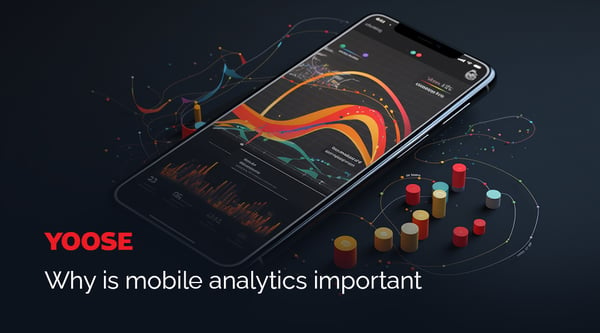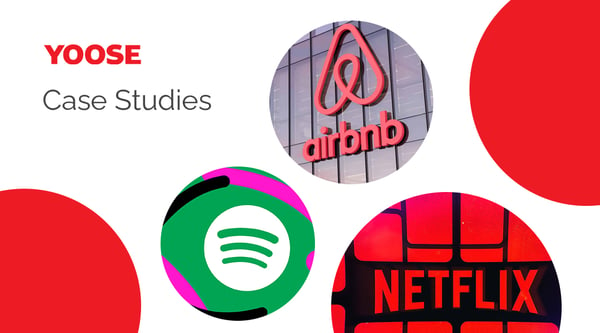Unlock full potential of mobile app with Mobile Analytics
Mobile analytics goes beyond measuring app downloads and usage. It enables you to gain insights into your users, enhance your app functionality, and boost your income. In this blog, we will demonstrate how to use mobile analytics to expand your business and accomplish your objectives.
What is mobile analytics?
Mobile analytics is the process of measuring and analyzing the behavior and performance of mobile applications, websites, and advertisements. Mobile analytics can help developers, marketers, and business owners to understand how users interact with their products, what features are most popular, what issues or bugs need to be fixed, and how to optimize the user experience and retention. Mobile analytics can also provide insights into the demographics, preferences, and feedback of mobile users, as well as the effectiveness and return on investment of mobile marketing campaigns.
.jpg?width=600&height=333&name=2109_SocialPost_01%20(1).jpg)
Why is mobile analytics important
The significance of mobile analytics in the modern business landscape cannot be overstated. Firstly, mobile analytics plays a pivotal role in enabling enterprises to refine their mobile offerings and enhance the overall user experience. By meticulously analyzing key indicators, including downloads, retention rates, engagement levels, conversion rates, revenue streams, and churn rates, enterprises can discern both strengths and areas of enhancement. Moreover, this allows for the systematic assessment of product iterations and gauging the resultant shifts in user behavior.

Secondly, this analytical approach empowers businesses to more effectively engage their target demographic, subsequently augmenting customer satisfaction levels. Through the segmentation of users based on various parameters—ranging from geographical location and device type to behavioral patterns and specific interests—enterprises can customize their content, promotional offers, and communication strategies to align with diverse user proclivities. Additionally, by harvesting user feedback and reviews, businesses gain invaluable insights into user perceptions of their offerings.
Lastly, mobile analytics serves as a robust tool for gauging the efficacy of marketing initiatives, thereby enhancing the return on investment. By meticulously monitoring traffic origins, user actions, and conversion outcomes, businesses can critically evaluate the success and cost-efficiency of various channels and strategic approaches. Furthermore, the real-time data derived facilitates the dynamic adjustment of marketing strategies to optimize outcomes.
How to implement mobile analytics
Step 1: Define your goals and key performance indicators (KPIs)
Before you start implementing mobile analytics, you need to have a clear idea of what you want to achieve with your app and how you will measure your success. You need to define your goals and KPIs that align with your business objectives and user needs.
You should also segment your users based on their characteristics, behavior, preferences, and needs. This will help you understand your different user groups and tailor your app experience accordingly.
Step 2: Choose your mobile analytics tool or platform
There are many mobile analytics tools and platforms available in the market, each with its own features, benefits, limitations, and pricing. You should choose the one that best suits your needs, budget, and technical capabilities. Some of the popular mobile analytics tools and platforms are:
- Google Analytics for Firebase: A free tool integrated with Firebase for app insights, covering user behavior to crash reporting. Enables app personalization based on user segments.
- Mixpanel: A paid service focusing on user behavior analysis, offering tracking of actions, revenue, and more. Enables customized user messaging based on behavior.
- Amplitude: A premium product analytics tool. Delve into user interactions, retention, and feedback-driven optimizations.
- Flurry: A free tool offering insights on app performance, user behaviors, and crash reasons. Facilitates behavior-matched push notifications.
Step 3: Implement your mobile analytics code
Once you have chosen your mobile analytics tool or platform, you need to implement its code in your app. This usually involves adding a software development kit (SDK) or a code snippet to your app code. You should follow the documentation and guidelines provided by your chosen tool or platform for this step.
You should also decide what events and properties you want to track in your app. Events are actions that users perform in your app, such as launching the app, signing up, making a purchase, etc. Properties are attributes that describe the events or the users, such as device type, location, gender, age group, product category, etc.
Only the events and properties that are relevant to your goals and KPIs should be tracked. Consistent naming conventions are also recommended for your events and properties across your app platforms (iOS, Android, web) and versions.
.jpg?width=600&height=333&name=2109_SocialPost_02%20(1).jpg)
Step 4: Analyze mobile analytics data
After you have implemented your mobile analytics code in app, you can start collecting and analyzing data. You should use the dashboard and reports provided by your chosen tool or platform to monitor your metrics and trends over time.
You should also use the advanced features of your tool or platform to perform deeper analysis on your data.
Step 5: Optimize your mobile app experience
The ultimate goal of mobile analytics is to optimize your mobile app experience for your users and your business. You should use your mobile analytics data to identify the strengths and weaknesses of your app, the opportunities and threats in your market, and the needs and expectations of your users.
Challenges
However, mobile analytics also poses some unique challenges that require careful consideration and planning. Some of these challenges are:- Data fragmentation: Mobile users often switch between different devices, platforms, networks, and locations, which can result in fragmented and incomplete data. For example, a user may start browsing a website on their laptop, then switch to their smartphone to complete a purchase. To get a holistic view of the user journey, mobile analytics needs to be able to track and stitch together data across multiple touchpoints and sources.
- Data quality: Mobile data can be affected by various factors that can compromise its quality and accuracy. For example, network latency, device compatibility, app crashes, ad blockers, and privacy settings can all interfere with data collection and transmission. Mobile analytics needs to implement robust data validation and quality assurance methods to ensure the reliability and validity of the data.

- Data privacy: Mobile users are becoming more aware and concerned about their data privacy and security, especially in light of recent data breaches and scandals. Mobile analytics needs to comply with various regulations and standards, such as GDPR, CCPA, and IDFA, that aim to protect the rights and interests of mobile users. Mobile analytics also needs to respect the preferences and consent of mobile users, and provide them with clear and transparent information about how their data is collected, used, and shared.
- Data analysis: Mobile data is often complex and voluminous, which can make it difficult to analyze and derive meaningful insights from. Mobile analytics needs to employ advanced techniques and tools, such as artificial intelligence, machine learning, and cloud computing, to process and analyze large amounts of mobile data efficiently and effectively. Mobile analytics also needs to present the data in a way that is easy to understand and act upon, such as through dashboards, reports, and visualizations.
Case study
Netflix
Challenge: Netflix faced stiff competition from other streaming services in India, such as Amazon Prime Video, Disney+ Hotstar, and Zee5. Netflix also had to deal with the challenges of low internet speed, limited data plans, and diverse languages and cultures in India. Netflix needed to find a way to stand out from the crowd and attract more users to download its app.
Solution: Netflix used mobile analytics to track and analyze various metrics related to its app store performance, such as impressions, page views, downloads, ratings, reviews, and conversions. Netflix also used mobile analytics to segment its users based on their location, device type, language, genre preference, and engagement level. Netflix then used this data to optimize its app store listing with relevant keywords, screenshots, videos, descriptions, and localized content. Netflix also tested different versions of its app store listing to see which one performed better.
Result: By using mobile analytics to optimize its app store listing, Netflix was able to increase its app downloads by 29% in India within six months. Netflix also saw a 17% increase in its app store rating and a 12% increase in its conversion rate. Netflix was able to reach more potential customers and grow its subscriber base in India.
Spotify
Challenge: Spotify faced several challenges in retaining its users and keeping them engaged. Spotify had to compete with other music streaming services such as Apple Music, YouTube Music, and Pandora. Spotify also had to deal with the issues of music piracy, ad blocking, and churn. Spotify needed to find a way to keep its users satisfied and loyal.
Solution: Spotify used mobile analytics to track and analyze various metrics related to its user behavior and engagement, such as sessions, events, funnels, cohorts, retention rate, churn rate, lifetime value (LTV), and net promoter score (NPS). Spotify also used mobile analytics to segment its users based on their demographics, preferences, behavior patterns, and subscription status. Spotify then used this data to improve its app features and functionality based on user feedback and behavior. Spotify also used mobile analytics to personalize its app content and recommendations based on user preferences and history.
Result: By using mobile analytics to improve its app features and personalization,
Spotify was able to improve its user retention by 25% within a year. Spotify also saw a 15% increase in its NPS and a 10% increase in its LTV. Spotify was able to provide a better user experience and more value to its users.

Airbnb
Challenge: Airbnb faced several challenges in increasing its bookings
and revenue. Airbnb had to compete with other online travel platforms such as Booking.com, Expedia, and TripAdvisor. Airbnb also had to deal with the challenges of trust, safety, quality, availability, and price in the travel industry.
Airbnb needed to find a way to make its app more user-friendly and appealing
to its users.
Solution: Airbnb used mobile analytics to track and analyze various metrics related to its user behavior and booking process, such as searches, views, clicks, bookings, cancellations, revenue, and average order value (AOV). Airbnb also used mobile analytics to segment its users based on their location, travel purpose, Budget, Preferences, and booking history. Airbnb then used this data to optimize its app design and functionality based on user feedback and behavior. Airbnb also used mobile analytics to optimize its app content and offers based on user preferences and history.
Result: By using mobile analytics to optimize its app design and content, Airbnb was able to increase its bookings by 18% within a year. Airbnb also saw a 12% increase in its revenue and a 8% increase in its AOV. Airbnb was able to provide a seamless and convenient booking process for its users.
Conclusion
Mobile analytics is a powerful tool that can help you measure and optimize your mobile app performance, user behavior, and marketing campaigns. By following the five steps of implementing mobile analytics, you can gain valuable insights into your app users, features, and outcomes. You can also use mobile analytics to improve your app design, functionality, personalization, and engagement.
At YOOSE, we know how to use mobile analytics to help you achieve your business goals and objectives, and stand out from the competition. If you want to learn more about mobile analytics and how to use it for your app, contact us today and we will be happy to help you.



